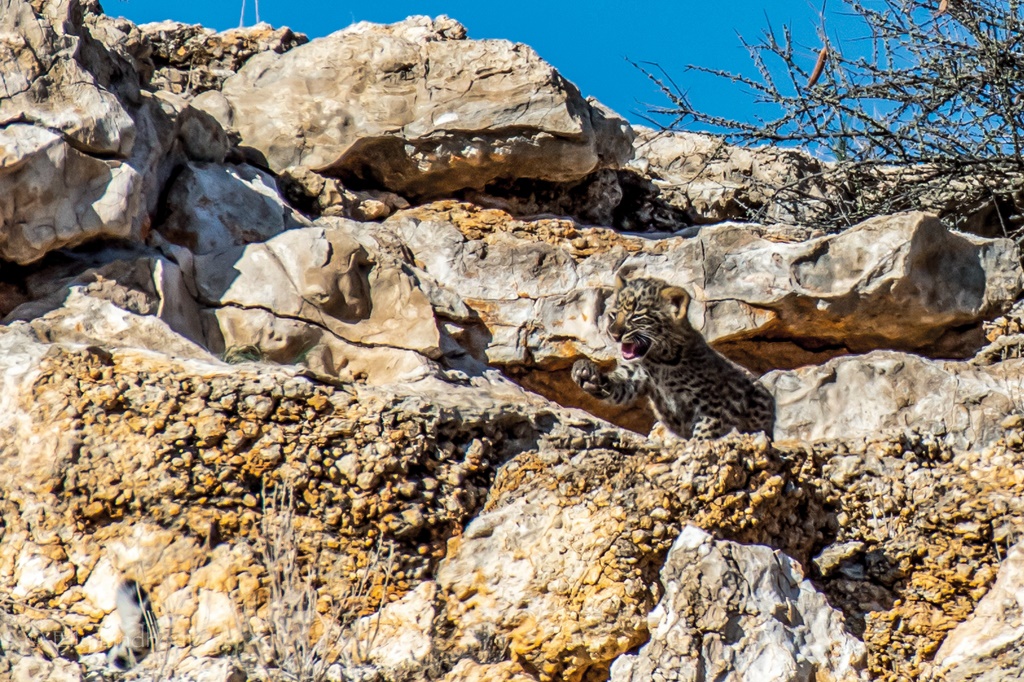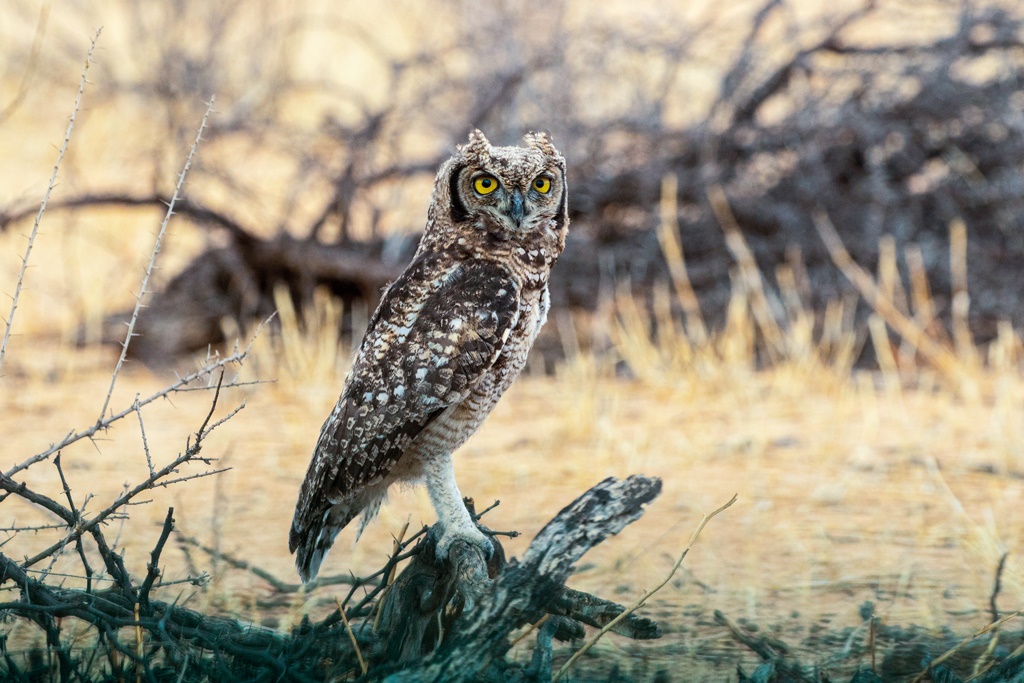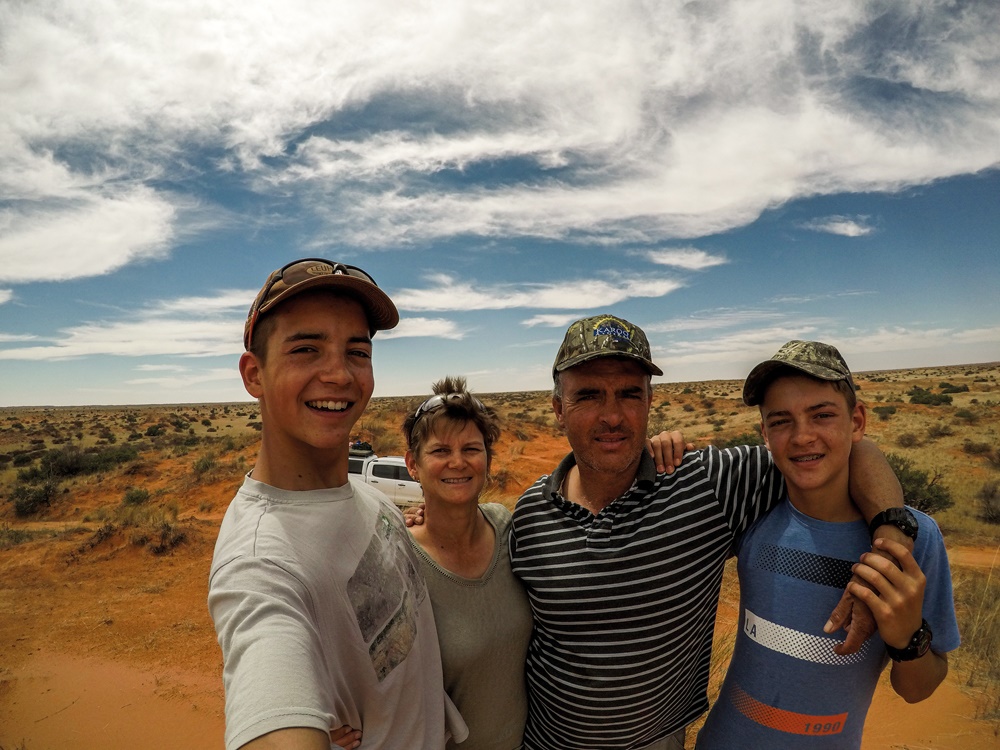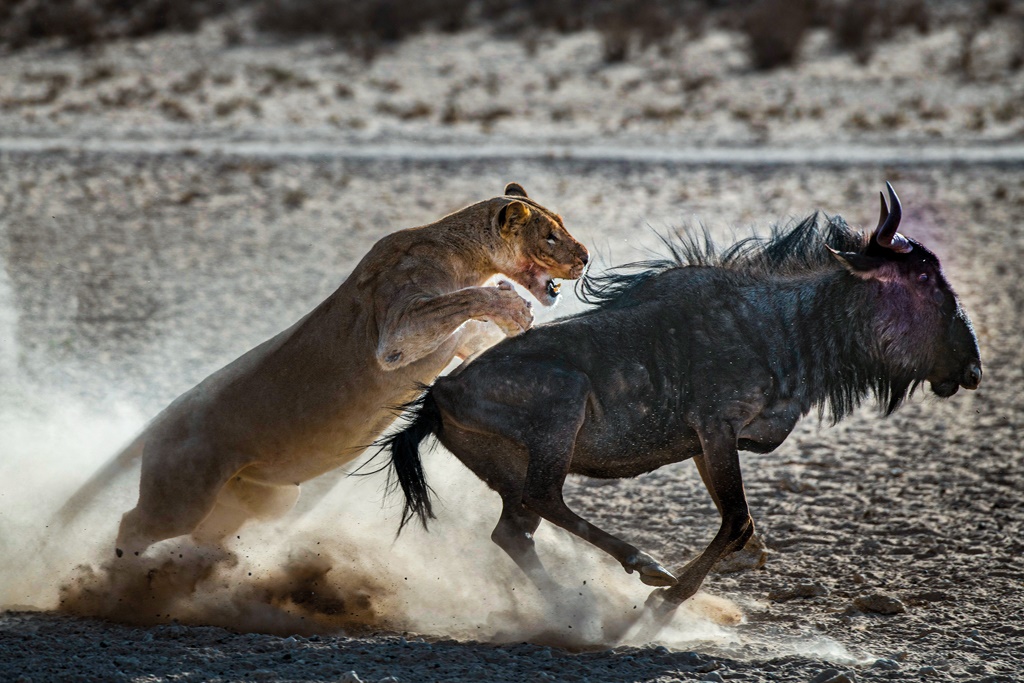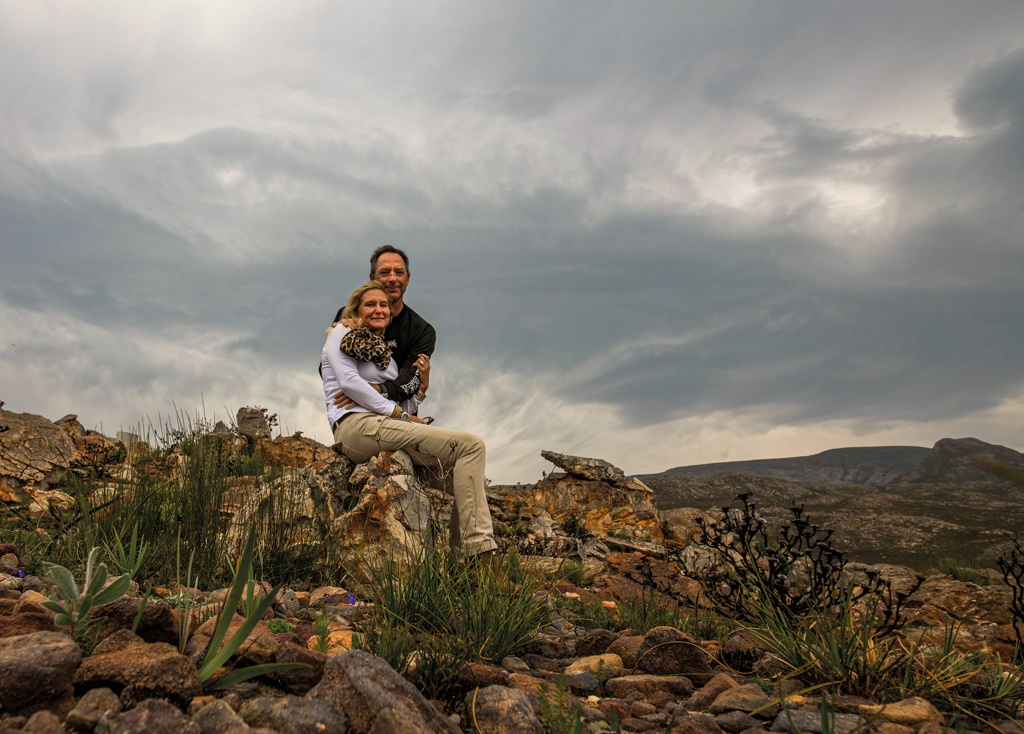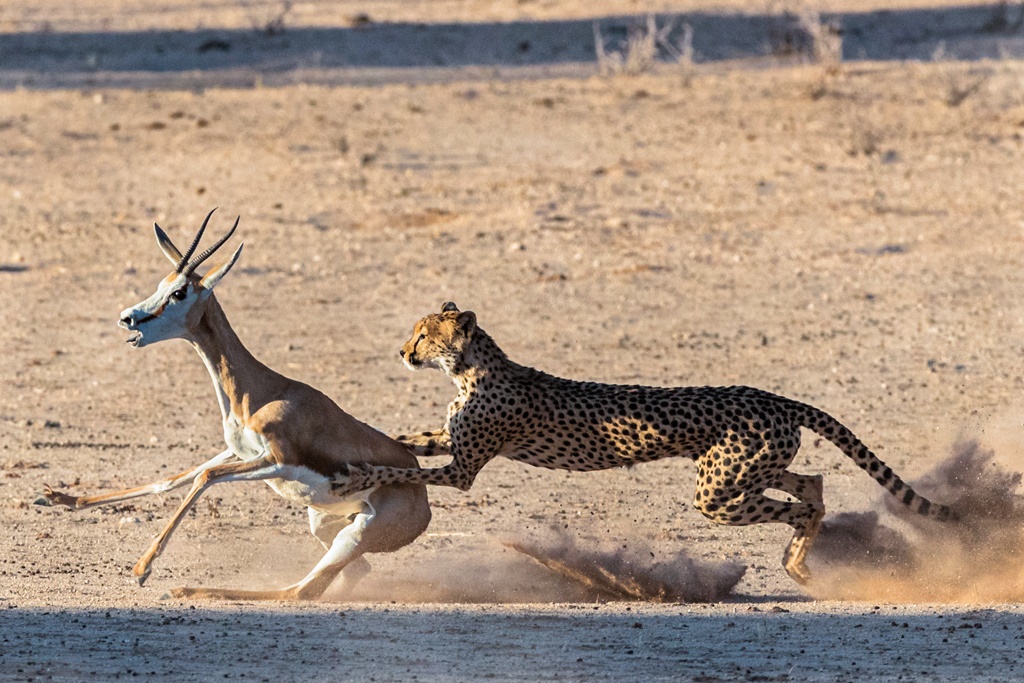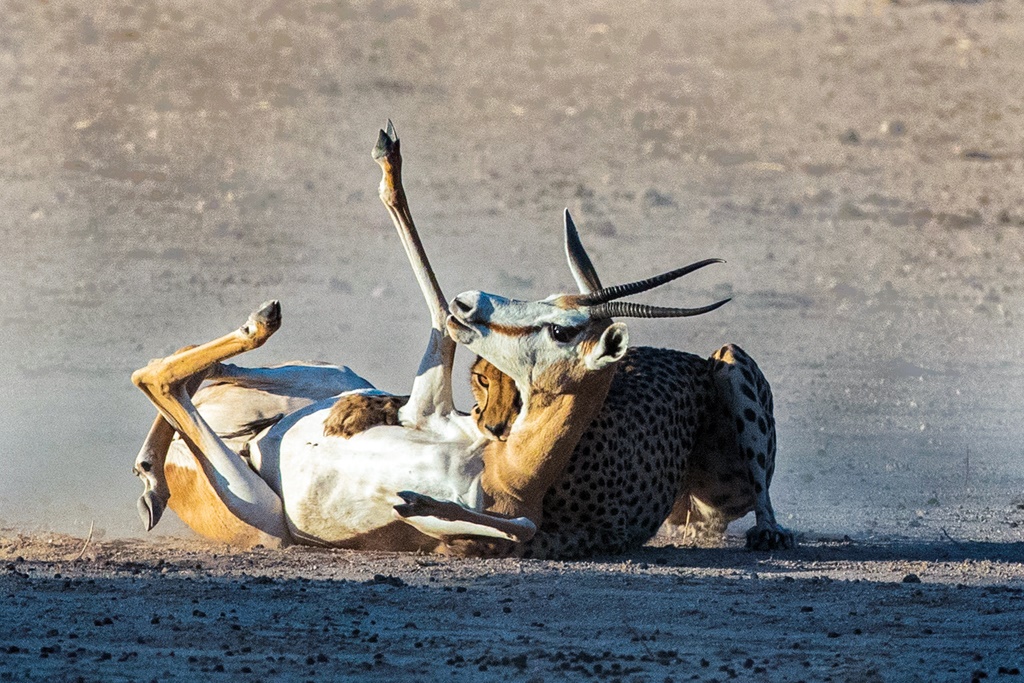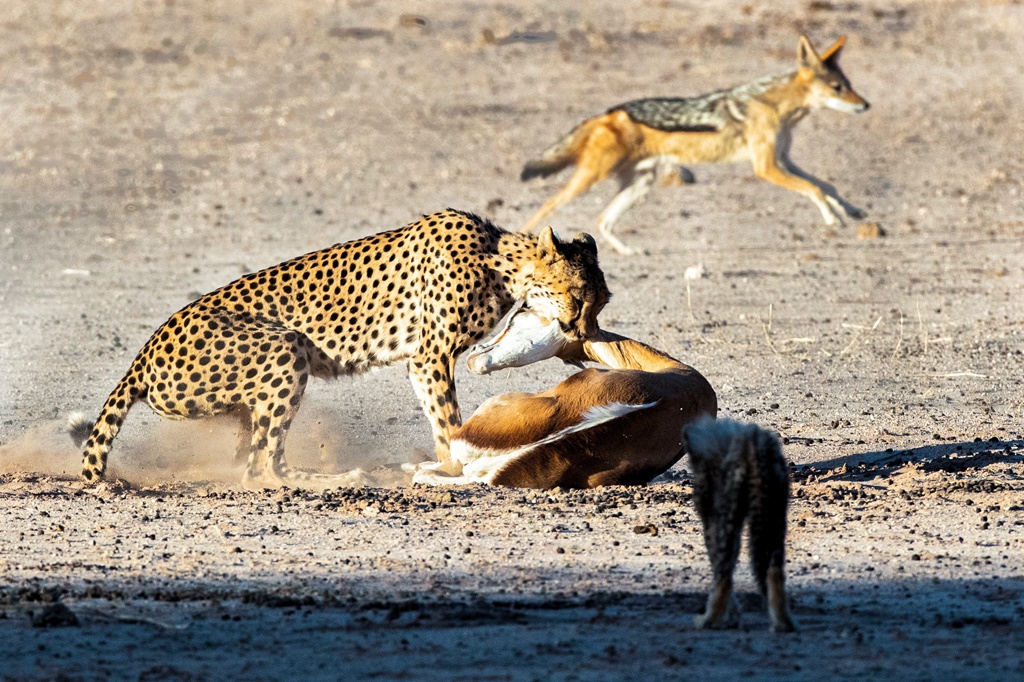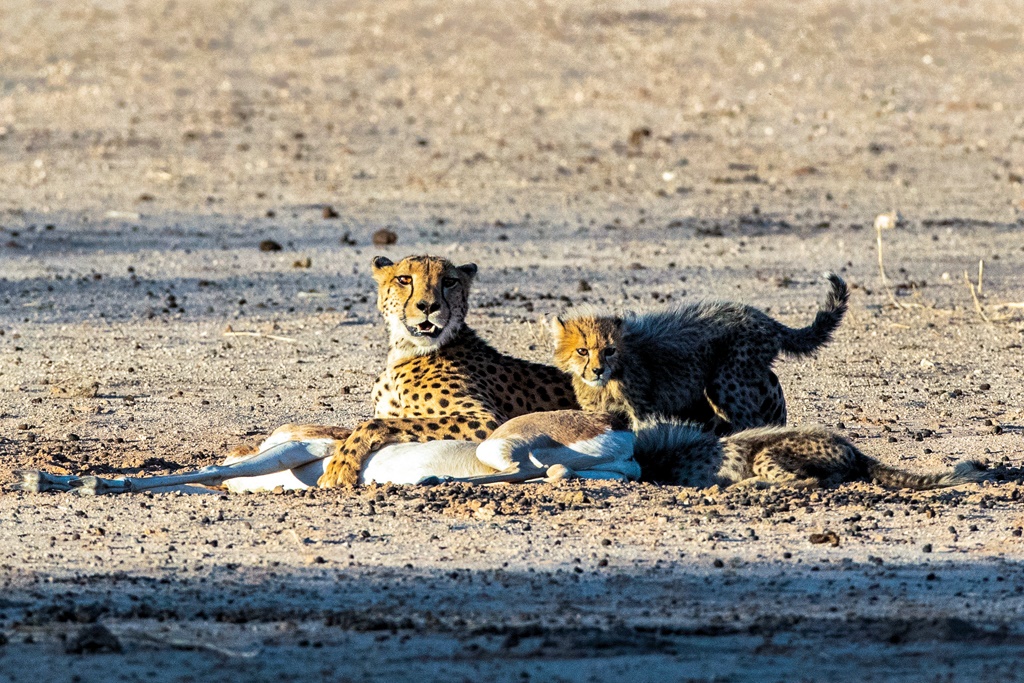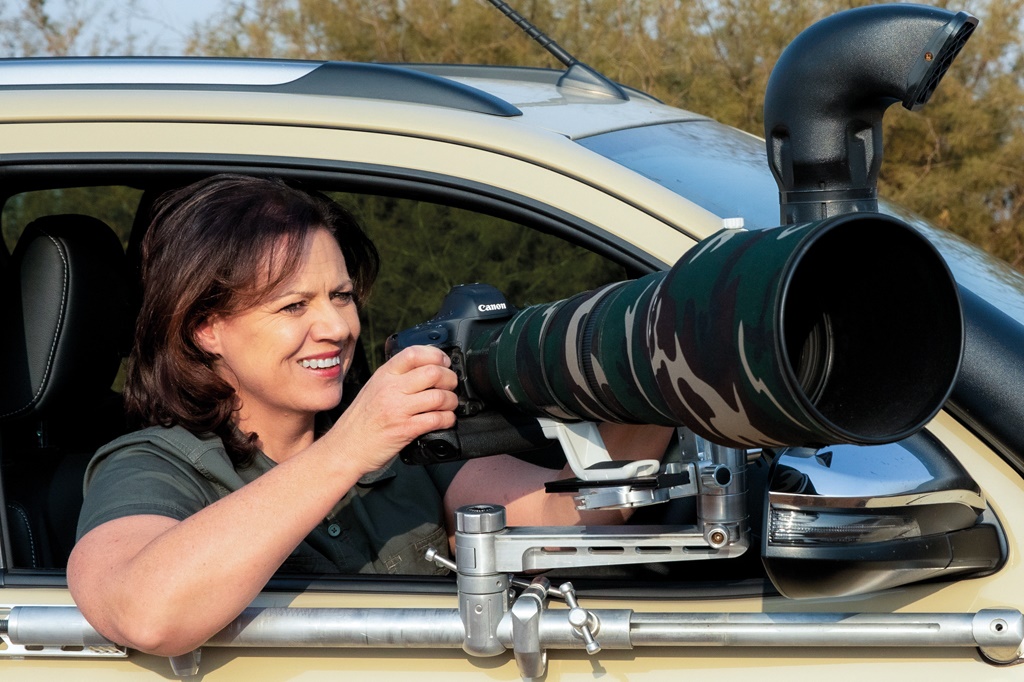
The Kgalagadi Transfrontier Park is remote but accessible; it’s wild, but you can stay in comfort in one of the rest camps. It also has the X-factor: You can lock eyes with a lion on a dune at sunrise, or hear the clang of horns as gemsbok bulls battle for dominance. We celebrate this wonderful park with amazing photos and stories from our readers.
ELLY LINDHOUT WRITES: Jan and I live in a small village in the Netherlands, just south of Rotterdam. We first visited the Kgalagadi in January 2017. Since my recent retirement, we are very fortunate to be able to stay in the park for longer periods – our last trip was 24 days long. What we love about the Kgalagadi is the absence of human presence. Except for the gravel roads, rest camps and waterholes, you don’t see buildings, advertising billboards or manmade structures in the landscape. You just see nature as it has been for centuries, although people who have known the area for 40+ years might debate this…
Still, driving around in the park, I can imagine the ancient place the Kgalagadi has always been. It makes me feel privileged, to experience this sense of undisturbed space and time – unique in our world today. We love the anticipation when you leave camp early in the morning. What will you see? You have no idea! Maybe only a few turtledoves at the waterhole, a pronking springbok or a magnificent gemsbok on the horizon... or a spectacular cheetah chase, or a lion on a kill!
If you choose to wait at the waterhole with the turtle-doves, there is always a chance that a lanner falcon will appear, with an opportunistic pale chanting goshawk or a tawny eagle in the vicinity, waiting to steal the kill from the falcon... But then, you might miss a thirsty lion coming to the next waterhole for a long drink after its early morning meal! Or secretary birds doing a spectacular mating dance in the riverbed.
Besides the wildlife, there are other perks for photographers, like the magnificent landscape, the big skies and incomparable light. There are no tarred roads, which make for more “natural” scenes. Also, because visitor numbers are limited, you can sometimes be alone at a great sighting, and it’s easier to manoeuvre into a good position for a better angle – you’re usually not in another photographer’s way.
This leopard cub photo was taken on 21 January 2020, near Bataluma waterhole. It’s one of the two recent cubs of a well-known Kgalagadi leopard called Miera. Miera’s range is generally between Auchterlonie and Veertiende Boorgat, along the Auob riverbed. She has raised several litters of cubs; these new ones were first seen on the morning I took the photo. Since we were the second vehicle at this sighting, we had a prime spot. Watching Miera interact with her tiny cubs for one and a half hours that day was incredible. This cub seemed to be the “naughty” one. Mom had her paws full and had to keep dragging the cub back to the spot where she’d hidden them. The other little one would just follow her obediently. Not this one!
Join the Kgalagadi Leopard Project group on Facebook – search for “KgalagadiLeopards”. They have a PDF guide that you can download, about all the known and commonly seen leopards and cheetahs in the park.
Follow Elly on Instagram: @ellylindhout
Number of visits to the park: 6
Favourite camps: Urikaruus, Grootkolk, Nossob and Mata-Mata
BOMBER KENT WRITES: In December 2019, my partner Debbie and I spent three weeks in the Kgalagadi. This photo was taken on the day we left Kieliekrankie, heading to Kalahari Tented Camp further up the Auob River road. We first stopped to take photos of a swallow-tailed bee-eater that had a nest on the side of the road. It was catching butterflies and other insects and taking them to the nest. Just past the Urikaruus waterhole, we saw a parked car – the people seemed to be watching ground squirrels in the riverbed. As we got closer, Debbie saw there was a Cape cobra with the squirrels!
Surprisingly, the other vehicle drove off and we were left alone at this incredible sighting. For the next 15 minutes, we were the only vehicle there. One of the squirrels, a female, repeatedly tried to bite and chase away the cobra. The cobra continuously struck at the squirrel, but never actually made contact. You could see by the squirrel’s teats that she was nursing babies. After maybe an hour, the snake went down a hole. The squirrel followed, but shot out again and ran off. The cobra didn’t reappear so we left the sighting. We assumed the battle had been about the snake gaining access to squirrel babies in the burrow…
The Kgalagadi is our favourite South African park. We love staying at the small wilderness camps because you get more time during the golden hour before sunset, when guests staying at the main rest camps have to start heading back. It’s the same in the morning – you can get to a prime spot long before someone who is staying at Nossob or Twee Rivieren. The roads in the park can get very corrugated and can rattle your teeth! Seeing the tractor on the road, dragging those tyres that help smooth out the corrugations, is always a welcome sight.
We’ve had many great sightings in the park, but even on a quiet day you can simply park near a camel thorn tree with a sociable weaver nest in the boughs and photograph the comings and goings of the birds.
Follow Bomber on Instagram: @bomber0707
Number of visits to the park: 5
Favourite camps: Grootkolk, Gharagab, Urikaruus and Rooiputs
MARIETHA MOOLMAN WRITES: We’ve been visiting the Kgalagadi for our annual family holiday since 2009. A night at Bitterpan is always a highlight – the whole family agrees on this. Bitterpan is one of the wilderness camps only accessible by 4x4, situated in the dunes between Nossob and Mata-Mata. The sandy 4x4 track over the dunes is always exciting to drive. We’ve seen brown hyenas, lions and even a leopard there. Nossob is our favourite rest camp. There are barking geckos in Nossob and it’s great fun to walk around and photograph them in the evenings. This keeps my eldest son, Hans- Willem, busy for hours. Nossob has a central location so you have more roads to drive – you can head either north or south for the day.
At Mata-Mata, the meerkats and owls are a big attraction – pearl-spotted owlet and southern white-faced scops-owl live in the camp and you often see spotted eagle-owl, Verreaux’s eagle-owl and barn owl.
This photo was taken in December 2016. It was early, before sunrise, and we were travelling north from Nossob. We pulled oveat Kwang waterhole. There were two tawny eagles at the waterhole, and a jackal soon arrived. One of the eagles chased after the jackal and it turned into a game: When the eagle landed on the ground, the jackal would also stop to rest.
The eagle would take off and chase the jackal again, and the cycle would repeat itself. This went on for quite some time until the jackal disappeared into the bushes and the eagle flew away. Cubitje Quap, north of Nossob, is our favourite waterhole. Bateleurs usually gather at Cubitje Quap in the middle of the day to drink water or to lie down in the hot dust. Namaqua sandgrouse like to drink here – they attract the raptors.
My youngest son Manus loves birds, especially raptors. He’s been an avid birdwatcher since he was six years old. In 2016, he saw a rare augur buzzard at Rooikop – the first time that bird had ever been seen in the Kgalagadi. The colour palette of the Kalahari makes for beautiful photos: red sand, yellow grass, dusty green camel thorn trees… It’s a great place for amateur photographers to practise, because the animals are abundant and there’s always action around the waterholes.
You never know what will happen next. We were watching lions at Marie se Gat south of Nossob one afternoon. They were lazing around under the trees near a carcass they’d picked clean. Two jackals were gnawing on the rib bones. It was a peaceful scene, until a cloud of dust erupted and we heard a jackal yelp. From the dust emerged a lioness with the dead jackal in her jaws! She brought the jackal over to the pride and put it down. The lions all sniffed the dead jackal. I felt quite sorry for the poor thing!
The Kgalagadi is never crowded. You can enjoy the sounds – and silences – of the wild. We stop for everything: a southern pale chanting goshawk hunting with a Cape cobra; a whistling rat; a scorpion; every little bird – even for red velvet mites. We stop and watch because if there’s one thing you have in the Kalahari, it’s time. Hans-Willem sums it up best: The Kgalagadi is not about special sightings – those are a bonus. You go there to experience the Kalahari Desert.
Number of visits to the park: 10
Favourite camps: Nossob, Mata-Mata and Bitterpan
Follow Marietha on Instagram: @marietham
WILLEM BRIERS-LOUW WRITES: I’ve only been to the Kgalagadi twice, but I know I’ll keep coming back to the park until I’m old and grey. I’ve always been fascinated by deserts and semi-deserts. In November 2017, my friend Charli de Vos and I set out from Cape Town in Charli’s Toyota Rav4. The route from Cape Town to the Kgalagadi is one of the most scenic in the country. We slept over in Augrabies Falls National Park to see the waterfall, and then it was Kgalagadi time!
We were about 3 km from the Twee Rivieren gate when we saw our first animals in the park: Three male cheetahs dining on a springbok! We spent two nights at Twee Rivieren and two nights at Mata-Mata. We saw lots of lions, and smaller predators like Cape fox, African wildcat and caracal. Many of the park’s special birds also made an appearance: pygmy falcon, kori bustard, crimson-breasted shrike, bateleur and Namaqua sandgrouse. But no brown hyena – that sighting still eluded us.
Our trip ended with two nights at Nossob, where we camped next to a friendly photographer. We got along well and decided to drive out to Marie se Draai to watch the sunset together. The sun was already casting long shadows when we saw something around a bend in the riverbed – a brown hyena! This strange looking animal was on its way to the waterhole for a sundowner. After about 20 minutes, once it had drunk its fill, it returned to the dunes. Just before it disappeared, it looked back as if to say: “Welcome to the Kgalagadi.”
Number of visits to the park: 2
Favourite camp: Nossob
Follow Willem on Instagram: @willemd_bl
MELANIE MASKE WRITES: Nick and I first visited the park in 2006 and we’ve been back almost every year since. Photography is my passion, and the park is a great place to practise it. Each visit is different. Over the years, we’ve seen the harshness of nature – when it’s dry and temperatures rise over 40° C – but we’ve also experienced nature’s abundance, when the veld is in full bloom after good rains.
Polentswa, a wilderness camp just north of Nossob on the Botswana side, is our favourite campsite. The waterhole there is magical: If you sit and wait, something will surprise you sooner or later. That’s why we visit the park: to reconnect with nature in its purest form. Sometimes, just the sound of a barking gecko at your campsite is enough to make you appreciate how special the place is.
This dramatic sighting happened early on the morning of 11 November 2019 at the Kij Kij waterhole, which is along the Nossob riverbed, not far from Twee Rivieren. As we approached Kij Kij, there were plenty of black-backed jackals feeding on an eland carcass. There was also a lioness lying under a tree guarding her kill – a young wildebeest. It was unclear whether the lioness had also killed the eland. She seemed to be quite full already but very protective of the wildebeest carcass.
I was busy photographing the jackal when another wildebeest appeared. Nick yelled and said the lioness was approaching! There was chaos as I tried to refocus and get onto the action. It all happened so fast – the next thing, the wildebeest was down! I asked my husband to reposition our Hilux double cab so I could get a better angle on the lioness with her fresh kill.
I got a few more shots and then the lioness went back to her earlier kill under the tree, to fend off the scavenging jackals. My husband kept an eye on her while I was focused on the wildebeest that had just been brought down. The waterhole was now getting quite some attention with a few more cars at the sighting. We had just settled down when the supposedly dead wildebeest raised its head!
The lioness got up and struck again, this time making sure the wildebeest was dead. What a morning to witness a wildebeest getting killed twice!
Follow Melanie on Instagram: @africanmamaske
Number of visits to the park: 14
Favourite camp: Polentswa
LOUISE VICTOR WRITES: I try to visit the Kgalagadi at least once a year. Sometimes I travel with someone, but I also go alone. I’m happiest in the Kgalagadi – those red dunes have a special place in my heart. The photo opportunities in the park are endless. You just have to drive slowly and keep your eyes open. Or stop at a waterhole, where there’s always something to see. Leeuwdril, near Twee Rivieren next to the Nossob road, is my favourite waterhole. It’s perfectly situated for morning light because the sun shines from behind your vehicle.
Every time I visit the Kgalagadi, something exciting happens, like the time I photographed a cheetah kill in December 2017… It happened like this: I was staying in Kieliekrankie Wilderness Camp and I went for a drive to Mata-Mata. I drove back to Kieliekrankie slowly, but there wasn’t much to photograph in the midday heat: Bigger animals were resting in the shade and birds were sitting in the trees.
Near Montrose waterhole I saw a springbok ewe walking with a limp. I realised that she was an easy target for a predator, but then she lay down under a tree so I carried on. About 3 km further, I saw them: a cheetah and her cubs. They were walking towards Montrose… My adrenaline started pumping. I’d always wanted to photograph a cheetah kill and it looked like things were falling into place.
I spent the afternoon shuttling between the injured springbok and the cheetahs. It was hot and the mother cheetah often sought out shade so her cubs could rest. It was late when a herd of springbok wandered away from Montrose and straight towards the cheetahs. The injured springbok joined the herd. I parked my vehicle halfway between the springbok and the cheetahs and prepared myself. I was so excited I was shaking – they were drawing close!
Three other vehicles were also on the scene. The adult cheetah saw the springbok approach and hid behind one of the vehicles. Chaos broke out when she launched herself at the injured springbok. The springbok managed to get back on its feet, but the cheetah soon got hold of it again. Once the springbok was dead, the cubs ran to their mom and had a feast. Six hours had passed since I’d first seen the injured springbok.
Number of visits to the park: 10
Favourite camps: Urikaruus and Kieliekrankie
Follow Louise on Instagram: @louise.victorphotography or visit her website louisevictorphotography.co.za
ROSE MILLS WRITES: After we retired, my husband Peter and I travelled South Africa extensively to experience more of our country. This has always included an annual visit to the Kgalagadi. In fact, my family and I have been visiting the Kgalagadi for the past 27 consecutive years. We have twice experienced severe droughts, but October 2019 was on another level. The eland herds from the Botswana side of the park migrated to the South African side, but they found no greener pastures: The moonscape riverbeds barely had any food and there was danger lurking all over. Lions were everywhere!
The local Nossob pride came out of “hiding”. They’d spent three days in the vicinity of the camp, and we’d spent most of our time in camp with this beautiful pride easy to see. We even spent a whole night in the camp hide, which overlooks a waterhole that is lit up at night, to watch the lions, who only appeared at sunrise.
In the afternoon, when practically the entire camp went out for a sunset drive, the lionesses brought their young to the waterhole. That’s when I took this photo of four of them drinking together. We watched for more than half an hour as they drank, played and interacted. What a very special, euphoric moment.
Later that evening, the sense of tranquillity was shattered. At 1 am, we awoke to a male lion roaring right outside our riverfront chalet. I shone the torch over the railing, where five females and a male were passing by within a metre! I felt quite safe at the sliding door – but then a huge female stopped, turned around and pierced my soul with her terrifying stare!
She moved towards me and I jumped back, quickly closing the door. The next thing, the lioness stood up on her hind legs with her paws on the windowsill on the riverbed side and peered into our bedroom!
The chalet is the actual camp perimeter. There’s electric fencing between the riverbed and the chalet, but it wasn’t working that night. Peter shouted, “Switch off the light! There’s only a windowpane between us!”
We watched the lions saunter down to the waterhole. Relieved, I walked onto the veranda to retrieve my tripod that I’d left outside. Then, to my horror, there was the lioness again!
Eventually she joined the others. They caught a gemsbok a little later. We heard them growling as they ferociously fed on their kill.
It was a huge lesson for us: Always respect the possible dangers of the wild. Even after all of these years, every time we visit, there’s something new to experience. The Kgalagadi always delivers!
Number of visits to the park: 28
Favourite camps: Nossob and Urikaruus
Follow Rose on Instagram: @rm_tours
Peter Mills passed away in August 2020. This article is dedicated to him and his love of nature.
012 428 9111




 Publications
Publications
 Partners
Partners




